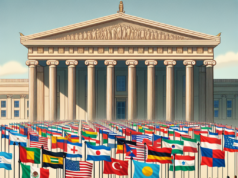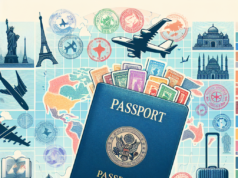
First Worship Center Opens at Processing Center for Immigrants
The United States has always been a country of immigrants, with people from all over the world coming here to find new opportunities for themselves and their families. However, when immigrants arrive, they face many challenges, from learning a new language to navigating a complex legal system. One of the most difficult challenges for immigrants is feeling isolated and disconnected from their communities. Many immigrants come from deeply religious backgrounds, and they may feel cut off from their faith communities when they arrive in the United States.
To help address this problem, the U.S. government has started to build worship centers in processing centers for immigrants. These centers are designed to provide a space for immigrants to practice their faith, connect with others who share their beliefs, and feel more connected to their home communities. In this article, we’ll take a closer look at the first worship center to open in a processing center for immigrants and explore its impact on the immigrant community.
Background: Immigration in the United States
The United States has a long history of immigration, with millions of people from around the world coming to the country each year. According to the Migration Policy Institute, around 44.9 million immigrants currently live in the United States, making up roughly 13.7% of the total population. These immigrants come from a wide range of countries, with the majority coming from Mexico, India, China, and the Philippines.
Despite this rich history of immigration, the process of entering the United States can be incredibly complicated and difficult for many people. Depending on the individual’s circumstances, they may face a range of hurdles, including long waiting periods, high application fees, and complex legal processes.
For many immigrants, the journey to the United States can also be dangerous, with many risking their lives to cross the border or travel by sea. According to the United Nations Refugee Agency, more than 2,000 migrants have died or gone missing while attempting to cross the U.S. border since 2014. These hardships make it all the more important for immigrants to have a sense of community and support once they arrive in the United States.
The First Worship Center for Immigrants
The first worship center to open in a processing center for immigrants is located in a large facility in San Diego, California. The center was established to provide a space for immigrants to practice their faith, no matter what religion they happen to practice.
The center includes several prayer rooms, each designed to accommodate different religious practices. There is a room for Christians, decorated with crosses and other traditional symbols, as well as a room for Muslims, complete with prayer mats and a qibla wall pointing towards Mecca. There is also a room for Jews and one for followers of other religions.
In addition to providing a space for prayer and worship, the center also offers various other resources and services for immigrants. There is a library of religious texts and literature, as well as a kitchen for preparing traditional meals. Staff members are available to offer counseling and support services to immigrants, as well.
Impact of the Worship Center
The impact of the worship center on the immigrant community has been significant. According to staff members, the center has provided a sense of community and support for many immigrants who may otherwise feel isolated and disconnected from their home communities.
One immigrant who uses the center regularly, a woman from Mexico who requested anonymity, said that the center has helped her to maintain her faith and connect with others who share her beliefs. It’s like a home away from home, she said. I feel like I’m not alone here.
Other immigrants echoed these sentiments, with many expressing gratitude for the opportunity to practice their faith and connect with others in a similar situation. For people who are going through the difficult process of immigrating to a new country, having a sense of community and support can be a crucial lifeline.
Government Support for the Worship Center
The U.S. government has been supportive of the worship center, recognizing the importance of providing resources and support for immigrants. The center was established in 2019 as part of a pilot program by the U.S. Citizenship and Immigration Services (USCIS).
In a statement, then-acting USCIS Director Ken Cuccinelli said that the center was designed to ensure that all those coming to our country have access to a place where they can practice their faith. Cuccinelli also noted that the center would help to fulfill our nation’s commitment to religious freedom.
More recently, the Biden administration has expressed support for the worship center and similar initiatives aimed at supporting immigrants. In a statement released in February 2021, President Biden announced plans to establish a task force to help reunite families who were separated at the U.S.-Mexico border and to restore our asylum system [4]. Such initiatives can help to create a more welcoming environment for immigrants and ensure that their needs are met during the immigration process.
Conclusion
The first worship center in a processing center for immigrants has already had a significant impact on the immigrant community, providing a sense of community and support for those going through the difficult process of immigrating to a new country. By recognizing the importance of religious freedom and community support, the U.S. government is taking steps to create a more welcoming environment for immigrants and ensure that their needs are met during the immigration process.
While there is still much work to be done to improve the immigration system in the United States, the establishment of the worship center is an important step in the right direction. Providing resources and support for immigrants can help to ensure that they are able to thrive and contribute to their communities, both in the United States and abroad.
On November 8, 2012, Immigration and Customs Enforcement (ICE) reported that the first-ever Detainee Intercultural Center was opened at the El Paso Processing Center. The Center in Texas lets people in ICE custody reflect, worship, and meditate.
Sandra Marinelarena, the interim assistant field officer director, states: “The El Paso Processing Center is the only ICE detention facility in the country with such a dedicated center.”
The opening at the El Paso Processing Center was attended by Father Joseph Molina of Most Holy Trinity Catholic Church in El Paso. He blessed the new building, but ministers in all religious denominations are available to give guidance at the Detainee Intercultural Center.
The El Paso Processing Center holds immigrant detainees who are currently waiting to be deported or waiting for their immigration case in the El Paso Immigration Court. The new facility was converted out of an older building, and the center can now hold about 840 inmates. The center is currently seeing an average attendance of 750 adult detainees every day.
ICE Field Office Director Adrian Macias stated: “The new Detainee Intercultural Center, not only serves the spiritual needs of people in our custody, but it’s part of the ICE’s larger effort to reform the immigration detention system as a whole. For the past three years, ICE has been making a concerted effort to move away from a punitive immigration detentions system to one that’s more suited to civil immigration. The Detainee Intercultural Center in El Paso is another positive step in that direction.”
The opening of the new Detainee Intercultural Center comes after government authorities reported they will start transporting illegal immigrants from Mexico to the interior of Mexico before they are released to local authorities. The new initiatives reduce the chances of the deported immigrant joining a criminal organization or being killed.
Source: U.S. Immigration and Customs Enforcement


























